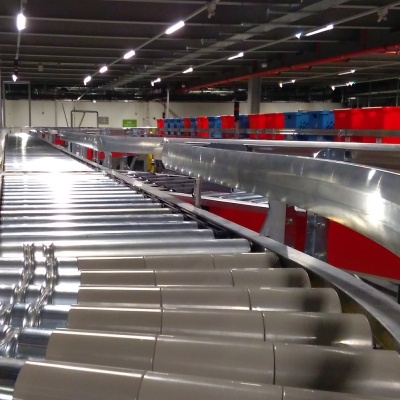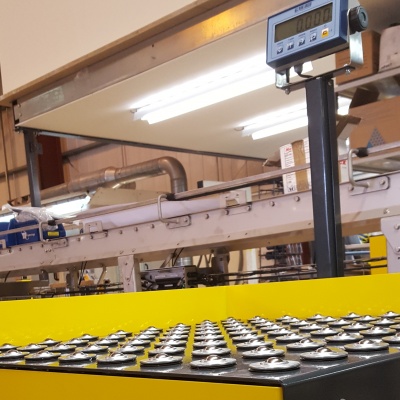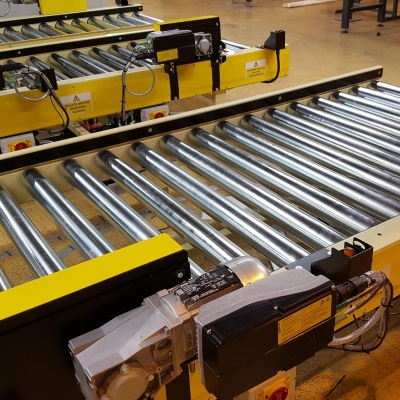As you might expect, not all conveyor solutions are the same. The necessity of having a conveyor system that can cope with your production environment and what you need it to do goes without saying. Making the right choice can be a very tricky proposition.
Conveyor systems have become an essential component in the safe and efficient running of most manufacturing and logistics businesses. They allow for the rapid movement of product around a factory or warehouse that would otherwise need to be done by forklifts, pallet trucks or human operators.
A well designed conveyor system can drastically improve the working environment, reduce unnecessary labour costs and greatly reduce the possibility of product damage or operator injury.
Choosing the right type of conveyors for your environment and production is essential.

Choosing the right conveyor system
There are a number of things to consider when looking into getting a conveyor system for your business, however it should all start with what you are looking to convey. Consider the following:
- Product. What are you looking to move? Your product is the most important consideration when looking to install a conveyor system. If it is food, particularly raw food, you are likely to need conveyors suitable for wash down environments and stainless steel construction.
- Product Dimensions. Length, width and height of your product. This will not only govern the size of the conveyor but give an idea as to how stable it will be when travelling.
- Product Variability. Do you have one size of product or many different sizes? If many what are the largest and smallest?
- Product Shape. Some products are easier to move than others, flat bottomed boxes are generally suitable for a number of different types of conveyors. Oddly shaped products my require more thought and may only be suitable for specific types of conveyor.
- Product Weight. What is the heaviest product you are looking to move on the conveyor?
- Product Throughput. How quickly do you need to get product from point A to point B?
The above information will give you a good start on selecting the right conveyor system for your business. Once you have given consideration to your product here are a few other factors to think about:
- Factory size and layout. Where can you physically run a conveyor system without blocking access doors, forklift routes, other machinery etc. Maybe your factory floor is very busy but you have plenty of room above to run a high level conveyor system.
- Level of automation required. How automated are you looking to be? You can go from simply transporting product from A to B in a straight line to fully automating the transportation, weighing, labelling and palletising of the product, including robot palletisers and pallet wrappers.
- Other equipment on site. Do you need the conveyor system to tie in with any existing equipment? Maybe you already have a case taper and need a conveyor to feed in cases or cartons.
- Budget and payback period. As with any capital investment the budget and the payback period of the equipment, taking into account labour and other cost reductions, need to be taken into consideration.
Main types of conveyor system
So what type of conveyor systems are available for you to go for? Here we will list and briefly explain some of the conveyor types available to you. Bear in mind that a conveyor system can be, and often is, made up of a mixture of different conveyor types depending on the requirements.

Gravity Roller Conveyors
The simplest and cheapest type of conveyors are gravity conveyors. Gravity conveyors are unpowered and rely on gravity to move product, by slightly declining the conveyor, or on operators manually pushing the product along the conveyor.
Used in a lot of distribution and logistics processes to move boxes/totes/parcels from one point to another. Gravity conveyors are also incredibly reliable and durable, and can convey a range of products, from lightweight boxes to pallets weighing several tonnes.
Gravity conveyors can come in various formats from full rollers to skate wheels and roller balls, allowing for product manipulation by operators. They can be fitted with braked rollers so that longer declines can be utilised without the threat of product picking up too much momentum.
It is very common to see gravity and powered conveyors used together to create a cost and energy efficient conveyor system.
Belt Conveyors
Belt conveyors are one of the most common and adaptable types of conveyor available today. They are used in a wide range of industries to carry a multitude of products. From simple, small belt conveyors to carry lightweight parts to large, heavy duty belt conveyors the list of products you can move on a belt conveyor is almost endless.
You can use belt conveyors to take products up or down from a mezzanine floor, round bends, through metal detectors and so much more.
Belt conveyors can be manufactured in stainless steel so as to be hygienic and wash down friendly in the food, beverage and pharmaceutical industries.
A standard belt conveyor is a relatively low cost way of transporting your product from one area of your factory to another.

Powered Roller Conveyors
When it comes to moving pallets, totes or boxes over long distances in a warehouse or factory then powered roller conveyors are the go to solution. Assuming of course that you considered your product and they are suitable for running on rollers!
There are a few different types of powered roller conveyor to be aware of, you have the heavier duty chain driven roller conveyor usually used for pallets or heavy loads. You then have the lighter duty roller conveyors either lineshaft driven or Zero Line Pressure zoned conveyors for carrying totes, boxes, parcels (what is ZLP conveyor?)etc.
Powered roller conveyor systems can come with merges, diverts, turntables, lifts and many more options to add automation to your process.
Overhead Conveyors
Overhead conveyors can be powered or free running, the powered conveyors utilise a chain running in a channel with attachments for hangers, these hangers can then be designed to hold the product it is transporting. You will see overhead conveyors a lot in the automotive industry carrying everything from full car chassis to bumpers and doors etc.
Slat Chain Conveyor
Slat chain conveyors are predominantly used in the food and pharmaceutical industries, particularly to carry cans and bottles. Plastic slats are also ideal for industries where hygiene is of the utmost importance as they can be regularly washed down and disinfected.
A slat chain conveyor can come with plastic slats or steel slats depending on the product you are looking to move and, as the chain is hinged in the centre and can flex, it can be used to move product around bends.
Evaluate Your Process
During the initial project phase it is a good idea to review the processes downstream of the proposed conveyor system to anticipate any new bottlenecks that may be created.
Quite often adding a conveyor system will result in dramatic productivity improvements and additional solutions may be needed for processes further along the line such as scanning, weighing and taping to keep up with the improvements.
If any of these processes are manual inputs, it is easy to see how operators may not be able to keep up with the new and faster system.
Get Expert Advice
The information above should, hopefully, give you a better understanding of the options you have available when looking to add a level of automation to your business.
We would always recommend that you get in touch with us to discuss your application, we are more than happy to attend site to look at your premises, products and discuss what you are trying to achieve before making recomendations.
Get in touch with us today to discuss your investment in automation.
Published: 6th June 2018
